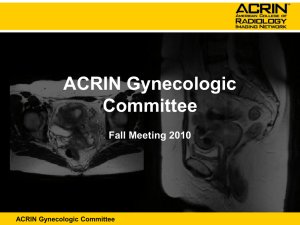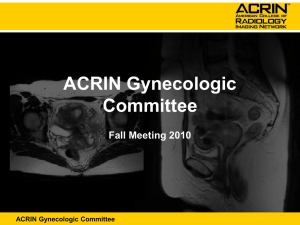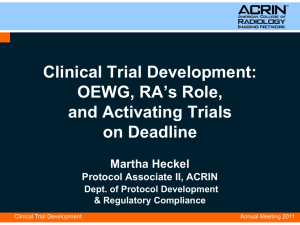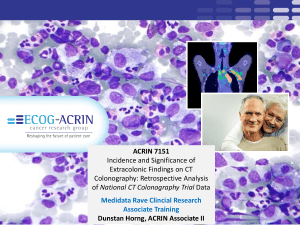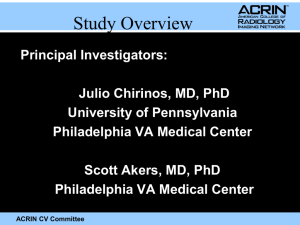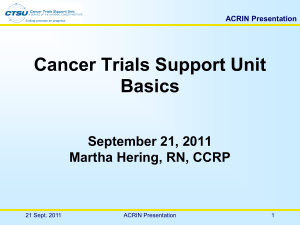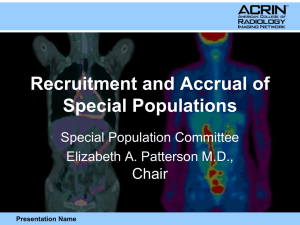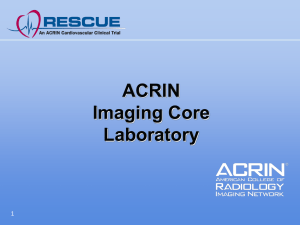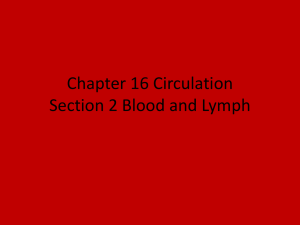ACRIN 6671/GOG 0233 Update and Questions
advertisement
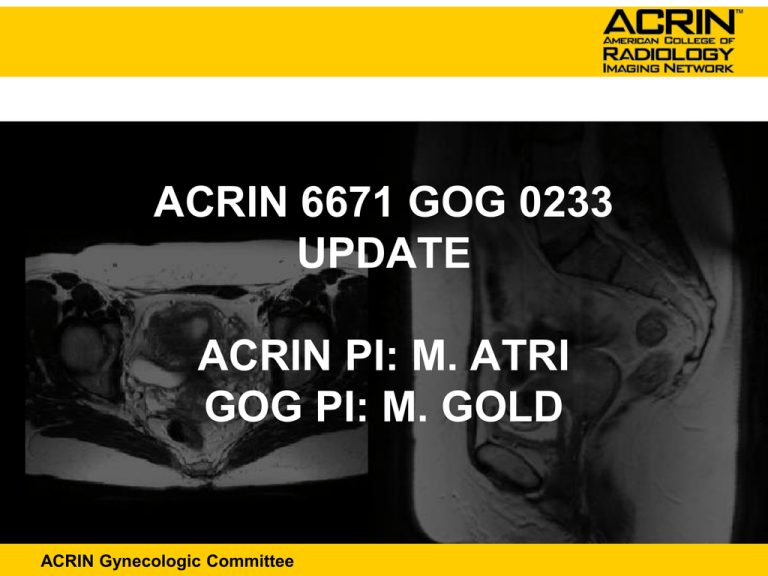
ACRIN 6671 GOG 0233 UPDATE ACRIN PI: M. ATRI GOG PI: M. GOLD ACRIN Abdominal Committee ACRIN Gynecologic Committee Lymph Node Evaluation What is the utility of lymph node evaluation in: Cervical Carcinoma Endometrial Carcinoma ACRIN Gynecologic Committee Cervical Carcinoma Early stage – Any (+) LN Lymph node metastases high risk factors for recurrence Identifies population needing adjuvant chemoradiation ACRIN Gynecologic Committee Early Stage Cervical Carcinoma Chemo-RT if one of the following: High Risk: Positive margin, parametrial extension, positive node (87% of CRT vs. 84% of RT) PFS OS 4-yr PFS 80% vs. 63%; p=0.003 4-yr OS 81% vs. 71%; p=0.007 •GOG 109 (Peters WA et. al. . J Clinic Oncol 18:1606-1613, 2000) ACRIN Gynecologic Committee Cervical Carcinoma Early stage – Any (+) LN Lymph node metastases high risk factors for recurrence Identifies population needing adjuvant chemoradiation Locoregionally Advanced – (+) PA LN Pelvic lymph nodes included in standard pelvic radiation field Para-Aortic (Abdominal) lymph node metastases results in extended field primary chemoradiation ACRIN Gynecologic Committee Locoregionally Advanced Cervical Carcinoma Risk of lymph node metastases increases with stage Stage IB1 IB2 2A 2B 3A 3B 4A % PALN (+) 1.7 11.9 2.4-18.2 16.7-32.8 33.3 24.9-31.1 12.5-33 ACRIN Gynecologic Committee Impact of Para-Aortic Evaluation on Survival Adjusted RR 1.51 (95% CI: 0.99-2.31), p=0.055 Adjusted RR 1.51 (95% CI: 0.99-2.31), p=0.055 ACRIN Gynecologic Committee Adjusted RR 1.60 (95% CI: 1.03-2.48), p=0.038 Importance of Detecting PALN Metastases Three-year Progression Free Interval & Overall Survival ACRIN Gynecologic Committee Endometrial Carcinoma Any (+) Lymph Node Lymph node metastases high risk factors for recurrence Identifies population needing adjuvant chemotherapy Avoids unnecessary post-operative treatment ACRIN Gynecologic Committee Endometrial Carcinoma Cannot reliably identify who does and does not have LN mets based on pathologic variables Only 10% of (+) nodes are palpable 37% of nodal mets are < 2 mm 3-5% of “low risk” pts (+) nodes In LN (+) patients, PALN involved in ~50%, only (+) site 8-17% ACRIN Gynecologic Committee LN Mets in Endometrial Carcinoma Depth of Invasion Grade G1 (N= 180) G2 (N= 288) G3 (N= 153) Endo Only (N= 86) 0 3% 0 Inner 1/3 (N= 281) 3% 5% 9% Mid 1/3 (N=115) 0 9% 4% Outer 1/3 (N= 139) 11% 19% 34% ACRIN Gynecologic Committee Distribution of Disease in Node (+) EM Patients 70 60 50 Creasman Schorge 40 Onda 30 McMeekin Otsuka 20 Katz 10 0 Pelvic Only Pel + PALN PALN only Any PALN Cancer 1987; Gyn Onc 1996; Br J Ca 1997,Gyn Onc 2001,Br J Ca 2002; Am J OB-GYN 2001 ACRIN Gynecologic Committee Endometrial Carcinoma PALN failure reduced from 39 to 13% in pts undergoing LN resection (Corn, Int J RBP 1992;24:223) Failure to sample systematically PLN/PALN leads to increased retroperitoneal failures (Chaung, Gyn Onc 1995;58:189) Less failures, improved PFS/OS in patients undergoing PALND (Mariani, Gyn Onc 2000;76:348) ACRIN Gynecologic Committee Survival Benefit Associated with Extensive Lymphadenectomy Percent Survival (%) 100 1-8 Nodes 9-16 Nodes ≥16 Nodes 75 (p=0.048) 0 0 50 150 100 Time (months) ACRIN Gynecologic Committee High Risk: Stage IB Grade 3 Stage IC Stage II Stage III Stage IV 5-Year DS Survival 1-8 Nodes: 90.4% 9-16 Nodes: 91.3% ≥16 Nodes: 94.0% 200 Chan et al, Cancer 2006 Endometrial Carcinoma GOG 33 - 621 Clinical Stage I patients 153 pts w/ G3 • 18% (+)PLN & 11% (+)PALN 97 pts w/ Cervical involvement • 16% (+)PLN & 14% (+)PALN GOG 210 – Restricted enrollment 947 patients 129 (13.6%) Stage IIIC 51 (5.4%) Stage IVB University of Oklahoma – 607 staged patients 47 (8%) w/ (+) Lymph Nodes • 43% (+)PLN / 40% (+)P&PALN / 17% (+)PALN ACRIN Gynecologic Committee ACOG Practice Bulletin Management of Endometrial Cancer Number 65, August 2005 “Most women with endometrial cancer benefit from systematic surgical staging” “Staging is prognostic and facilitates targeted therapy to maximize survival and minimize the effects of undertreatment and over-treatment” “Retroperitoneal lymph node assessment is a critical component of surgical staging and is associated with improved survival” “Palpation of the retroperitoneum is an inaccurate measure and cannot substitute for surgical dissection of nodal tissue” Reaffirmed 2009 ACRIN Gynecologic Committee OUTLINE COMBIDEX MRI review Update on ACRIN6671/GOG0233 ACRIN Gynecologic Committee COMBIDEX MRI REVIEW Study Protocol Requirement Interim analysis after 30 positive patients Sensitivity > 60% to continue Combidex provider stopped providing the agent in October 2009 New Amendment to include endometrial cancer ACRIN/GOG approval to review Combidex MRI data ACRIN Gynecologic Committee COMBIDEX MRI REVIEW Study Protocol Requirement Seven central readers Initial training on 3 test cases Submission and approval of forms Two step review Combidex insensitive sequence review • Data submission and query All sequence review ACRIN Gynecologic Committee REVIEW PROCESS 5 NA, 2 European readers All academic abdominal imagers 5/7 had experience with USPIO review Effect of experience 3 at ACRIN headquarter, 4 at their institutions Review process complete Abstract submission to ASCO 2011 ACRIN Gynecologic Committee COMBIDEX MRI REVIEW Challenges (N: 33 Patients) Reader selection Handful of experienced readers 2 of more experienced readers dropped out/replaced Difficult to bring reviewers to ACRIN headquarter Difficult to entice them to meet timelines (5 months) Long review process [3 days (3x8hrs)] ACRIN Gynecologic Committee IMAGING REVIEW Literature Pubmed & Google Scholar Keywords Imaging review Imaging review and clinical trial radiology review study Off-site vs. On-site imaging review ACRIN Gynecologic Committee NUMBER OF ARTICLES 0 Tumour Size Measurement in an Oncology Clinical Trial: Comparison Between Off-site and On-site Measurements Clinical Radiology, 58:311 ACRIN Gynecologic Committee IMAGING REVIEW Questions On-site vs. Off-site Reviewer fatigue Familiarity with PACS system Role of experience Role of sub-specialization Reviewer accountability ACRIN Gynecologic Committee IMAGING REVIEW Questions • Role of experience • Combination of Rev. • Role of fatigue • Compare half days • Accountability • Authorship • PACS system • ACRIN vs. Commercial ACRIN Gynecologic Committee SCHEMA (ENDOMETRIUM) Endometrial cancer patients eligible for lymphadenectomy Grade 3 endometrioid; clear-cell, serous papillary, or carcinosarcoma (any grade); and Grade 1 or 2 endometrioid with cervical stromal involvement overt on clinical examination or confirmed by endocervical curettage Pre-operative PET/CT Scan of the abdomen and pelvis and chest No evidence of disease outside of the pelvis or abdominal nodal region amenable to biopsy or sampling (i.e. intrahepatic, pulmonary, or thoracic or supraclavicular lymphadenopathy on PET/CT) ACRIN Gynecologic Committee Evidence of disease outside of the pelvis or abdominal nodal region amenable to biopsy or sampling (i.e. intrahepatic, pulmonary, or thoracic or supraclavicular lymphadenopathy on PET/CT) Advanced Lymph adenopathy not amenable to surgery SCHEMA (ENDOMETRIUM) No evidence of disease outside of pelvis or abdominal nodal region on PET/CT Total abdominal hysterectomy, bilateral salpingo-oopherectomy, and abdominal & pelvic lymph node sampling Evidence of disease outside of the pelvis or abdominal nodal region on PET/CT Advanced Lymph adenopathy not amenable to surgery Biopsy of metastatic disease Bx (-) outside of the pelvis or abdominal nodal region by FNA, core biopsy, or surgical biopsy Bx (+) Lymphadenectomy Chemo-Radiation Therapy abandoned, Chemotherapy to start within four weeks Standard institutionalProtocol treatment for Advanced of enrollment into the /Recurrent Disease study ACRIN Gynecologic Committee ACRIN 6671/GOG 0233 UPDATE Required sample size Cervix Endometrium 165 215 Number of accruing centers Number of accrued patients Cervix Endometrium ACRIN Gynecologic Committee ? ? ??? DISCUSSION Possibility of review during accrual Suggestions to increase accrual ACRIN Gynecologic Committee
